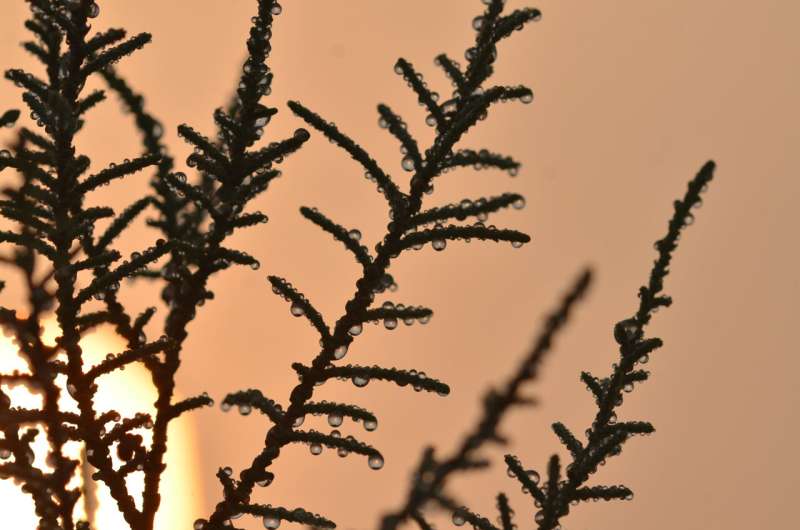This article has been reviewed according to Science X's editorial process and policies. Editors have highlighted the following attributes while ensuring the content's credibility:
fact-checked
peer-reviewed publication
trusted source
proofread
Researchers reveal how common desert shrub efficiently harvests water from the air

A team of scientists, led by Post-Doctoral Associate Marieh Al-Handawi and Professor of Chemistry Panče Naumov from NYU Abu Dhabi's Smart Materials Lab and NYU Abu Dhabi Institute's Center for Smart Engineering Materials (CSEM) has revealed the mechanism a desert plant native to the United Arab Emirates uses to capture moisture from the desert air in order to survive.
The identification of this unique mechanism, in which the plant excretes salts to extract and condense water onto the surface of its leaves, has the potential to inspire the development of new technologies, and improve existing ones such as cloud seeding, to harness atmospheric water resources.
Tamarix aphylla, or athel tamarisk, is a halophytic desert shrub, meaning it can survive in hypersaline conditions. Over time, the plant has evolved to take full advantage of the prevalent humidity and fog occurrences in the UAE.
Many plants and animals that inhabit arid regions have developed water-harvesting mechanisms and morphophysiological traits which have given them the ability to utilize abundant, untapped sources of water such as fog and dew. The fundamental principles governing this natural water collection serve as an inspiration for emerging water-collection technologies, which are developed to maximize the efficiency of the existing methods for harvesting aerial humidity.
In the paper titled "Harvesting of Aerial Humidity with Natural Hygroscopic Salt Excretions," published in the journal Proceedings of the National Academy of Sciences , the researchers present their exploration of the physicochemical aspects of salt release and water collection mechanisms by Tamarix aphylla that has allowed it to thrive in hypersaline sands.
The plant absorbs saline water from the soil through its roots, filters out the salt, and expels the concentrated salt solution onto the outer surface of its leaves. The researchers found that as the salt solution undergoes evaporation, it transforms into a hygroscopic crystalline mixture composed of at least 10 different minerals.
It was discovered that some of these salt crystals have the ability to attract moisture from the air even when the humidity levels are reasonably low (~55% relative humidity). This moisture condenses onto the surface of the plant's leaves and is then absorbed.
"Our findings not only reveal a unique, natural complex mechanism for water utilization, they also open prospects for designing environmentally benign formulations based on a biogenic salt mixture that could be used for efficient harvesting of aerial water or cloud seeding at low humidity," said lead author Al-Handawi.
"This holds the promise of revolutionizing cloud seeding practices by rendering them more effective and environmentally friendly, while also aligning with our responsibility to use the planet's scarce water resources wisely."
The global scarcity of freshwater has stimulated research into alternative water-harvesting technologies to supplement the existing conventional resources in water-stressed locations. Within a broader context, this natural mechanism developed by the research team for harvesting humidity using environmentally benign salts as moisture adsorbents could provide a bioinspired approach that complements the currently available water collection or cloud-seeding technologies.
More information: Harvesting of aerial humidity with natural hygroscopic salt excretions, Proceedings of the National Academy of Sciences (2023). DOI: 10.1073/pnas.2313134120. doi.org/10.1073/pnas.2313134120
Journal information: Proceedings of the National Academy of Sciences
Provided by New York University





















